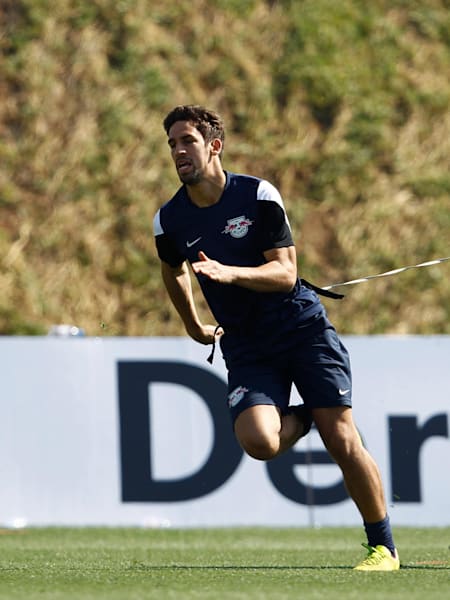If you aspire to any half-decent level of football, you'll need to work on your stamina.
The average professional player now covers over 10km in a 90-minute match. These days it’s not just about increasing lung capacity – the demands of the game have increased so exponentially that being bigger, more powerful and explosive is more critical than ever.
With that, here’s the only football fitness training regime you need.
1. Be able to run for days
Get yourself on a treadmill or find any open space fit for running. Interval training is not a traditional stamina builder but it is what you’ll find most Premier League players doing to help improve their VO2 Max (the maximum rate at which someone’s body can consume oxygen during exercise), hitting maximum sprinting at high tempo before jogging and then going all out once more, allowing them to build the stamina and flourish deep into added time.
The drill: Perform four minutes jogging and four minutes tempo run repeated four times. Try mixing footwork around cones with your sprinting as well.
Traditionally something only wingers had, it’s now vital for players in all positions to have sprint speed. Come the end of their career, even modern greats including Rio Ferdinand will confess how hard it can be without it.
Maximising your own potential to run fast for shorter bursts will stand you head and shoulders above the rest, so try using weighted sled pulls and parachute sprints, which will help push your legs well beyond their means.
By building up strength in the hamstrings and quadriceps with isometric and eccentric movements under increased pressure, you’ll become a speed merchant in no time.
The drill: Five rounds of 50m sled pulls, or bungee cords, with 30 seconds rest between.
Superstars like Eden Hazard seem able to turn a corner and already be in the middle of next week, but while it may look natural, much of it comes down to hard work. It’s all about explosive power.
Training for this is not for the fainthearted and involves maximum effort and excellent technique, however with this comes great reward, turning you into a deadly number 10 with a frightening turn of speed.
To achieve this, perform plyometric movements such as squat thrusters, burpees with tuck jumps with any sort of jump squat, including plyometric box jumps, and soon opponents will be eating your dust.
The drill: Four sets of 10 single-leg box jumps on each side, increasing the height of the box each week.
4. Improve your change of direction
It’s all well and good if you’re fast, but if that stops at straight line speed then you’ll be restricted to the wings. Every footballer should be able to change direction at any second and do so quickly, without the risk of injury and keeping the ball well under control.
Traditional cone drills are an easy way to improve a player’s agility, including slalom runs and shuttle runs. Don’t forget the ball, either; the real gamechanger is being able to run and turn at full tilt, but still keep the ball under control.
The drill: Slowly slalom through 10-20 cones placed in a zigzagging formation, and back again, increasing your speed each time, your foot pushing the ball throughout.
5. Develop rock solid core stability
When looking for a player who really does maximise every aspect of their physique to their advantage, you’d be hard pressed to look past Lionel Messi. Evading defenders through incredible balance and speed as they all bounce off his diminutive frame, the pintsized playmaker is on another level to the rest of his rivals.
Not all of us are blessed with a low centre of gravity though, so how can you emulate that with an extra few inches? The trick is to give yourself a rock-solid core.
But before you head off to do sit-ups and crunch, true core stability comes from mixing in some unstable exercises to your training regime. This means squatting on a Bosu-ball, using a T-bar for single-leg Romanian deadlift or getting on a TRX for some plank jacks, all of which will test your core and improve your stability when jostling for the ball.
The drill: Any of the above for six reps each, with a three-second break between.
6. Make yourself stronger
Ignore strength training at your peril. Advances in sports science have awoken the football world to the positive effects of disciplines like Olympic lifting and general resistance training.
Big compound movements such as squats, deadlifts and lunges all have a hugely positive effect when it comes to things like explosive power, overall speed, agility and – to a degree – core stability. However, the biggest benefit of strength training lies in injury prevention; a solid resistance program promotes strength gains in ligaments, tendons and the general skeletal structure.
The drill: Five sets of six reps of deadlifts, squats and lunges throughout the week.
Given the hectic demands of the modern game, sandwiching in training session after training session between games, you might imagine footballers don’t have much time to recover. Behind the scenes, however, they leave plenty of time for rest. Recovery should be a big part of your training regime too and making sure you’re doing it properly could be stopping you hitting your peak fitness.
Training to aid your body in its regeneration is vital. Foam rolling is especially good for preventing a build-up of fascia and reducing DOMS (delayed onset muscular soreness). You should also make sure that your nutrition is correct and take time to stretch post-match.
Ensure you: Spend at least 10 minutes after a training session stretching or foam rolling your lower body.
Find more like this by liking Red Bull on Facebook and following Red Bull Ireland on Twitter. .png)





